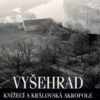The book deals with the central residential area of the hillfort of Vyšehrad that, during the Middle Ages, constituted a prominent political and power centre of the Czech state and for nearly three quarters of a century also the location of the ruler’s residence. It results from a comprehensive treatment of extensive, but hitherto unexploited sources obtained through large-scale archaeological excavations since 1924.
The book consists of 22 original chapters written by specialists in prehistoric and medieval archaeology, bioarchaeology, historical metallurgy, and geology. After an introductory part (Part I) which introduces the circumstances of the formation of the corpus of material sources, there are analytical chapters devoted to the finds from prehistory (Part II) and the Medieval and Modern periods (Part III). The final part (Part IV) presents a synthesis of the findings and evaluates them in a broader archaeological and historical context.
Besides the very first systematic treatment of remains of prehistoric occupation at Vyšehrad (Early and Middle Eneolithic), the monograph offers an insight into the earliest phase of existence of the medieval hillfort (ca. 980–1070) and portrays the architectonic and urbanistic appearance of the subsequent early Romanesque residence of the P?emyslids (ca. 1070–1140), which preceded the building of a stone palace at the Prague Castle by more than half a century. Furthermore, it provides a detailed characterization of the architectonic appearance and symbolism of the palatial complex renewed by the Luxembourg dynasty (1348–1420) and captures the main traits of its subsequent degradation in the post-Hussite period. An emphasis is put on the material culture, social and economic aspects of life at the acropolis, and other topics. The text is amply illustrated by photographic and drawn documentation.
Vyšehrad. Fürstliche und der Royal Akropolis. Zeugnis der Archäologie — Vyšehrad. Knížecí a královská akropole. Sv?dectví archeologie
35,00 €
inkl. 7 % MwSt. zzgl. Versandkosten
| Gewicht | 3714 g |
|---|---|
| Bestellnr | 6-8-62 |
| Produktgruppe | Verkaufsprogramm |
| Reihe | Tschechische Literatur |
| Hauptgruppe | Einzeltitel |
| Untergruppe | Einzeltitel |
| ISBN | |
| KurzbezTitel | Vyšehrad. Fürstliche und der Royal Akropolis. Zeugnis der Archäologie — Vyšehrad. Knížecí a královská akropole. Sv?dectví archeologie |
| Autor | Václav Moucha, Bo?ivoj Nechvátal, Ladislav Varadzin, et al. — Herausgeber: Archeologický ústav AV ?R, Praha, v.v.i. |
| Erscheinungsjahr | Praha 2015 |
| TechnischeAbgaben | 959 Seiten, zahlreiche Abbildungen und Tafeln in Farbe und S/W, Beiträge in Czechisch, Englisch und Zusammenfassung in Deutsch, 30 x 21, 3 cm, Festeinband |
| Inhalt | The book deals with the central residential area of the hillfort of Vyšehrad that, during the Middle Ages, constituted a prominent political and power centre of the Czech state and for nearly three quarters of a century also the location of the ruler’s residence. It results from a comprehensive treatment of extensive, but hitherto unexploited sources obtained through large-scale archaeological excavations since 1924. The book consists of 22 original chapters written by specialists in prehistoric and medieval archaeology, bioarchaeology, historical metallurgy, and geology. After an introductory part (Part I) which introduces the circumstances of the formation of the corpus of material sources, there are analytical chapters devoted to the finds from prehistory (Part II) and the Medieval and Modern periods (Part III). The final part (Part IV) presents a synthesis of the findings and evaluates them in a broader archaeological and historical context. Besides the very first systematic treatment of remains of prehistoric occupation at Vyšehrad (Early and Middle Eneolithic), the monograph offers an insight into the earliest phase of existence of the medieval hillfort (ca. 980–1070) and portrays the architectonic and urbanistic appearance of the subsequent early Romanesque residence of the P?emyslids (ca. 1070–1140), which preceded the building of a stone palace at the Prague Castle by more than half a century. Furthermore, it provides a detailed characterization of the architectonic appearance and symbolism of the palatial complex renewed by the Luxembourg dynasty (1348–1420) and captures the main traits of its subsequent degradation in the post-Hussite period. An emphasis is put on the material culture, social and economic aspects of life at the acropolis, and other topics. The text is amply illustrated by photographic and drawn documentation. |
| Besonderheiten |

 Archeologicke rozhledy 2017 sešti 2
Archeologicke rozhledy 2017 sešti 2 




